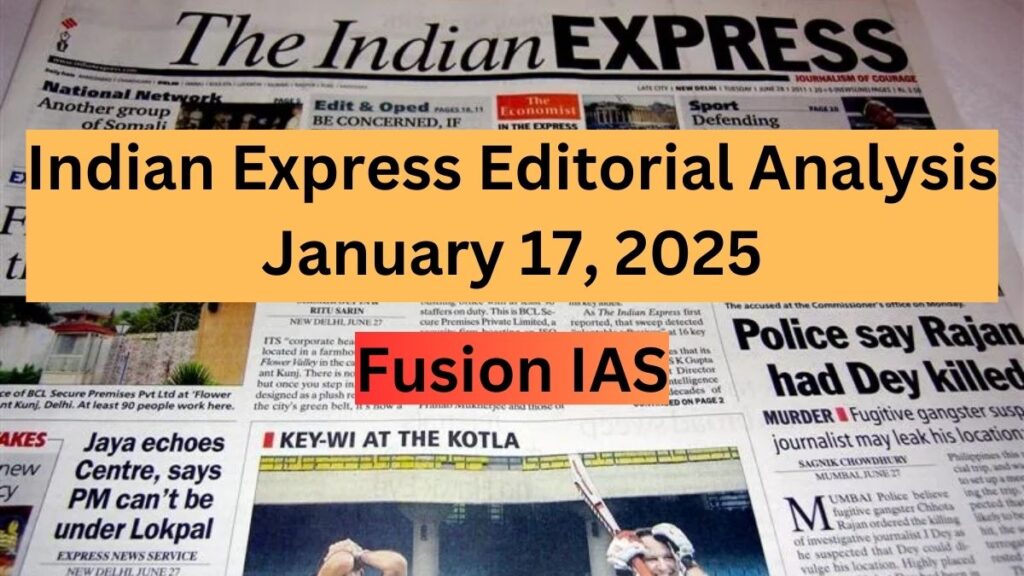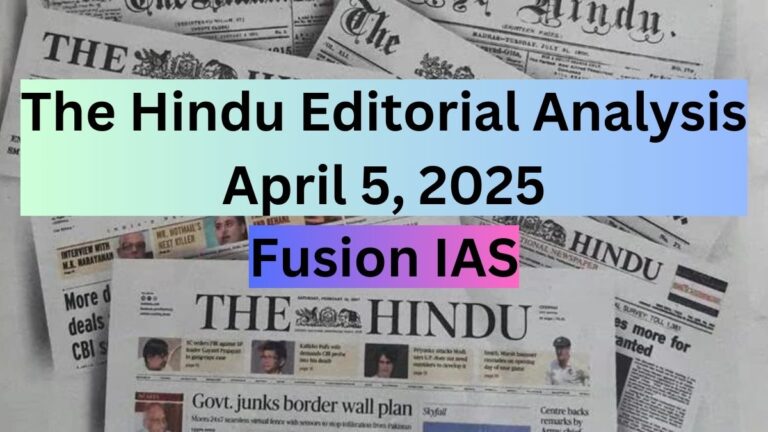
For UPSC CSE aspirants, analyzing editorials from The Indian Express is essential to build a comprehensive understanding of current affairs, policy debates, and socio-economic challenges. Here’s a structured breakdown of the editorial themes covered on January 15, 2025, tailored for UPSC preparation:
1. Israel-Hamas ceasefire is welcome – but peace won’t be easy
- Ceasefire Agreement:
- A ceasefire deal has been brokered between Israel and Hamas, effective January 19, 2025.
- It follows a previous brief pause in November 2023, which saw a prisoner exchange.
- Hostage and Prisoner Exchange:
- Phase 1: Release of 33 Israeli hostages and around 1,000 Palestinian prisoners.
- Phase 2: Negotiations for further exchanges to begin after the 16th day of Phase 1.
- Mediators and International Role:
- The agreement was mediated by the outgoing Biden administration and Qatar.
- Egypt to assist in evacuating injured Gazans for medical treatment.
- Humanitarian Implications:
- Facilitates the flow of humanitarian aid to Gaza.
- Gaza’s infrastructure is severely damaged; over 46,000 Palestinians and 2,000 Israelis have died in the conflict.
- Challenges to Peace:
- Intense animosity and hatred between the parties make reconciliation difficult.
- Legal challenges in Israel over prisoner releases and opposition from hardline ministers.
- No clarity on full withdrawal of Israeli forces from Gaza, a Hamas precondition.
- Role of International and Regional Actors:
- Uncertainty over the involvement of the Iran-backed “axis of resistance” (Hezbollah, Houthis).
- Reconstruction efforts in Gaza require international support and assurance against future conflicts.
- Palestinian Authority’s Role:
- Post-ceasefire administration of Gaza to be led by the Palestine National Authority (PNA).
- Challenges due to Hamas’s control of Gaza since 2007 and internal Palestinian divisions.
- Hamas Leadership Crisis:
- Senior Hamas leaders eliminated during the conflict, creating a leadership vacuum.
- Israel has weakened Hamas militarily and curtailed its social welfare activities.
- Political Context:
- Netanyahu’s hardline approach has damaged adversaries like Hezbollah, Iran, and Syria.
- Ceasefire partly motivated by fears over the incoming Trump administration.
- Uncertainty in the Middle East:
- The fragile agreement could collapse due to unforeseen developments.
- Peace efforts remain uncertain due to the volatile and unpredictable nature of the region.
2. Express View: ISRO’s latest success, an example to follow
- Spadex Mission Success:
- ISRO achieved a significant milestone by successfully docking two satellites in space during the Spadex mission.
- This capability is essential for future projects like a permanent space station and human lunar missions.
- Applications of Docking Technology:
- Critical for Chandrayaan-4, which aims to bring back lunar samples.
- Enhances India’s capability for advanced space missions.
- Global Recognition:
- ISRO is now one of the top space agencies globally, alongside only 3-4 others to achieve such feats.
- India is positioned in the top tier of nations in space technology.
- India’s Technological Aspirations:
- Space technology is a key area where India leads, but significant gaps remain in fields like Artificial Intelligence, quantum systems, and clean energy.
- Bridging these gaps is vital for India’s future global standing and economic growth.
- Factors Behind ISRO’s Success:
- Autonomy in planning, recruitment, and expenditure.
- Consistent political support and approval for scientific decisions.
- A culture of innovation and long-term vision.
- Replicating the ISRO Model:
- Scientists suggest using ISRO’s approach as a template for other critical sectors like AI, clean energy, and quantum technology.
- Building ISRO-like institutions for other scientific domains is challenging but worth exploring.
- Strategic Importance of Technology:
- Critical technologies will drive India’s economy and strategic self-reliance in the coming decades.
- Support, nurturing, and special liberties are necessary for emerging technology sectors.
- Broader Lessons:
- ISRO’s achievements underscore the importance of autonomy, long-term planning, and consistent backing from policymakers.
- These principles can be applied to foster growth in other scientific and technological fields.
3. Atmanirbhar at sea
- Historic Induction of Naval Platforms:
- Prime Minister Narendra Modi inaugurated three major naval platforms — INS Surat (destroyer), INS Nilgiri (frigate), and INS Vagsheer (submarine) — on January 15 in Mumbai.
- This event underscores India’s focus on indigenisation under the “Atmanirbhar Bharat” initiative.
- Maritime Heritage and Strategic Vision:
- PM Modi highlighted India’s maritime legacy, referencing the Chola dynasty and Chhatrapati Shivaji Maharaj.
- Introduced the acronym SAGAR (Security and Growth for All in the Region) in 2015, which aims to establish India as a key player in the Indian Ocean Region (IOR).
- Key Features of INS Surat:
- Fourth ship of the P15B Guided Missile Destroyer Project.
- 75% indigenous content claimed, though critical weapon systems are sourced externally.
- India’s Naval Position Globally:
- True Value Rating (TrV) places India at 7th globally, with 103 naval units and a TrV of 100.5.
- The US leads with a TrV of 323.9, while China follows closely at 319.8.
- Despite professionalism and credibility, the Indian Navy’s size and capability remain modest compared to China and the US.
- Budgetary Constraints:
- India’s defence budget (2023) is $84 billion, compared to $916 billion (US) and $330 billion (China).
- Only 17-18% of India’s defence budget is allocated to the navy, compared to 25% by the US and China.
- Challenges in Indigenisation:
- Claims of indigenisation (e.g., 75% for INS Surat) often mask dependency on foreign suppliers for critical systems.
- BrahMos missile is a notable success, but there is an urgent need to scale up indigenous R&D.
- Shipbuilding Efficiency Gap:
- India took 31 months to construct the 7,400-ton INS Surat, while China completed a 4,000-ton frigate in 4.5 months.
- Significant investment and efficiency improvements are needed in the Indian shipbuilding sector to compete globally.
- Strategic Importance of Maritime Power:
- India’s favourable maritime geography provides opportunities for influence in the Indo-Pacific.
- PM Modi emphasised the navy’s role as a first responder in the IOR and India’s support for an open and secure Indo-Pacific, indirectly addressing China’s growing assertiveness.
- Way Forward:
- Invest in Indigenous R&D: Enhance technological competence and design proficiency in core military capabilities.
- Increase Naval Budget: Align defence spending with maritime aspirations.
- Focus on Indigenisation: Reduce dependency on foreign suppliers for critical components.
- Streamline Shipbuilding Processes: Improve efficiency and technological capabilities to compete with global standards.
- Conclusion:
- While India’s naval advancements, including the commissioning of INS Surat, INS Nilgiri, and INS Vagsheer, are commendable, true self-reliance (atmanirbharta) requires sustained efforts in technology, manufacturing, and R&D.
- Strategic investments and reforms in the defence sector are vital to realising India’s maritime vision and securing its position as a major naval power.
Disclaimer:
This analysis is based on the editorial content published in Indian Express and is intended solely for informational and educational purposes. The views, opinions, and interpretations expressed herein are those of the author of original article. Readers are encouraged to refer to the original article for complete context and to exercise their own judgment while interpreting the analysis. The analysis does not constitute professional advice or endorsement of any political, economic, or social perspective.
Follow Fusion IAS


